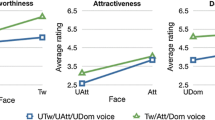Abstract
In human mate choice, sexually dimorphic faces and voices comprise hormone-mediated cues that purportedly develop as an indicator of mate quality or the ability to compete with same-sex rivals. If preferences for faces communicate the same biologically relevant information as do voices, then ratings of these cues should correlate. Sixty participants (30 male and 30 female) rated a series of opposite-sex faces, voices, and faces together with voices for attractiveness in a repeated measures computer-based experiment. The effects of face and voice attractiveness on face-voice compound stimuli were analyzed using a multilevel model. Faces contributed proportionally more than voices to ratings of face-voice compound attractiveness. Faces and voices positively and independently contributed to the attractiveness of male compound stimuli although there was no significant correlation between their rated attractiveness. A positive interaction and correlation between attractiveness was shown for faces and voices in relation to the attractiveness of female compound stimuli. Rather than providing a better estimate of a single characteristic, male faces and voices may instead communicate independent information that, in turn, provides a female with a better assessment of overall mate quality. Conversely, female faces and voices together provide males with a more accurate assessment of a single dimension of mate quality.


Similar content being viewed by others
References
Abitbol, J., Abitbol, P., & Abitbol, G. (1999). Sex hormones and the female voice. Journal of Voice, 13, 424–446.
Apicella, C. L., Feinberg, D. R., & Marlowe, F. W. (2007). Voice pitch predicts reproductive success in male hunter-gatherers. Biology Letters, 3, 682–684.
Baayen, R. H., Davidson, D. J., & Bates, D. M. (2008). Mixed-effects modelling with crossed random effects for subjects and items. Journal of Memory and Language, 59, 390–412.
Bates, D., & Maechler, M. (2009). lme4: Linear mixed-effects models using S4 classes. R package version 0.999375-32. Retrieved from http://CRAN.R-project.org/package=lme4.
Bruckert, L., Lienard, J. S., Lacroix, A., Kreutzer, M., & Leboucher, G. (2006). Women use voice parameters to assess men’s characteristics. Proceedings of the Royal Society B, 273, 83–89.
Candolin, U. (2003). The use of multiple cues in mate choice. Biology Reviews, 78, 575–595.
Collins, S. A. (2000). Men’s voices and women’s choices. Animal Behaviour, 60, 773–780.
Collins, S. A., & Missing, C. (2003). Vocal and visual attractiveness are related in women. Animal Behaviour, 65, 997–1004.
Cunningham, M. R., Roberts, A. R., Barbee, A. P., Druen, P. B., & Wu, C. H. (1995). Their ideas of beauty are, on the whole, the same as ours: Consistency and variability in the cross-cultural perception of female physical attractiveness. Journal of Personality and Social Psychology, 68, 261–279.
Dabbs, J. M., & Mallinger, A. (1999). High testosterone levels predict low voice pitch among men. Personality and Individual Differences, 27, 801–804.
Enders, C. K., & Tofighi, D. (2007). Centering predictor variables in cross-sectional multilevel models: A new look at an old issue. Psychological Methods, 12, 121–138.
Evans, S., Neave, N., Wakelin, D., & Hamilton, C. (2008). The relationship between testosterone and vocal frequencies in human males. Physiology & Behavior, 93, 783–788.
Feinberg, D. R. (2008). Are human faces and voices ornaments signalling common underlying cues to mate value? Evolutionary Anthropology, 17, 112–118.
Feinberg, D. R., Debruine, L. M., Jones, B. C., & Little, A. C. (2008). Correlated preferences for men’s facial and vocal masculinity. Evolution and Human Behavior, 29, 233–241.
Feinberg, D. R., Jones, B. C., Debruine, L. M., Moore, F. R., Law-Smith, M. J., Cornwell, R. E., et al. (2005). The voice and face of woman: One ornament that signals quality? Evolution and Human Behavior, 26, 398–408.
Fraccaro, P. J., Feinberg, D. R., Debruine, L. M., Little, A. C., Watkins, C. D., & Jones, B. C. (2010). Correlated preferences for femininity in female faces and voices. Evolutionary Psychology, 8, 447–461.
Guilford, T., & Dawkins, M. S. (1991). Receiver psychology and the evolution of animal signals. Animal Behaviour, 42, 1–14.
Hodges-Simeon, C. R., Gaulin, S. J. C., & Puts, D. A. (2011). Voice correlates of mating success in men: Examining “contests” versus “mate choice” modes of sexual selection. Archives of Sexual Behavior, 40, 551–557.
Hoffman, L., & Rovine, M. J. (2007). Multilevel models for the experimental psychologist: Foundations and illustrative examples. Behavior Research Methods, 39, 101–117.
Hollien, H. (1960). Some laryngeal correlates of vocal pitch. Journal of Speech and Hearing Research, 3, 52–58.
Hönekopp, J. (2006). Once more: Is beauty in the eye of the beholder? Relative contributions of private and shared taste to judgments of facial attractiveness. Journal of Experimental Psychology, 32, 199–209.
Hughes, S. M., Dispenza, F., & Gallup, G. G. (2004). Eratings of voice attractiveness predict sexual behavior and body configuration. Evolution and Human Behavior, 25, 295–304.
Jennions, M. D., & Petrie, M. (1997). Variation in mate choice and mating preferences: A review of causes and consequences. Biological Reviews, 72, 283–327.
Johnston, V. S., Hagel, R., Franklin, M., Fink, B., & Grammer, K. (2001). Male facial attractiveness: Evidence for hormone-mediated adaptive design. Evolution and Human Behavior, 22, 251–267.
Jones, B. C., Debruine, L. M., Perrett, D. I., Little, A. C., Feinberg, D. R., & Law-Smith, M. J. (2008). Effects of menstrual cycle phase on face preferences. Archives of Sexual Behavior, 37, 78–84.
Keating, C. F. (1985). Gender and physiognomy of dominance and attractiveness. Social Psychology Quarterly, 48, 61–70.
Lander, K. (2008). Relating visual and vocal attractiveness for moving and static faces. Animal Behaviour, 75, 817–822.
Law-Smith, M. J., Perrett, D. I., Jones, B. C., Cornwell, R. E., Moore, F. R., Feinberg, D. R., et al. (2006). Facial appearance is a cue to oestrogen levels in women. Proceedings of the Royal Society B, 273, 135–140.
Møller, A. P., & Pomiankowski, A. (1993). Why have birds got multiple sexual ornaments? Behavioral Ecology and Sociobiology, 32, 167–176.
Oguchi, T., & Kikuchi, H. (1997). Voice and interpersonal attraction. Japanese Psychological Research, 39, 56–61.
Partan, S., & Marler, P. (1999). Communication goes multimodal. Science, 283, 1272–1273.
Penton-Voak, I. S., & Chen, J. Y. (2004). High salivary testosterone is linked to masculine male facial appearance in humans. Evolution and Human Behavior, 25, 229–241.
Penton-Voak, I. S., Jacobson, A., & Trivers, R. (2004). Populational differences in attractiveness judgments of male and female faces: comparing British and Jamaican samples. Evolution and Human Behavior, 25, 355–370.
Penton-Voak, I. S., Jones, B. C., Little, A. C., Baker, S., Tiddeman, B., Burt, D. M., et al. (2001). Symmetry, sexual dimorphism and facial proportions and male facial attractiveness. Proceedings of the Royal Society B, 268, 1617–1623.
Perrett, D. I., Lee, K. J., Penton-Voak, I., Rowland, D., Yoshikawa, S., Burt, D. M., et al. (1998). Effects of sexual dimorphism on facial attractiveness. Nature, 394, 884–887.
Perrett, D. I., Penton-Voak, I. S., Little, A. C., Tiddeman, B. P., Burt, D. M., Schmidt, N., et al. (2002). Facial attractiveness judgements reflect learning of parental age characteristics. Proceedings of the Royal Society B, 269, 273–880.
Pfaus, J. G., Kippin, T. E., & Centeno, S. (2001). Conditioning and sexual behavior: A review. Hormones and Behavior, 40, 291–321.
Puts, D. A. (2010). Beauty and the beast: Mechanisms of sexual selection in humans. Evolution and Human Behavior, 31, 157–175.
Puts, D. A., Gaulin, S. J. C., & Verdolini, K. (2006). Dominance and the evolution of sexual dimorphism in human voice pitch. Evolution and Human Behavior, 27, 283–296.
R Development Core Team (2009). R: A language and environment for statistical computing. Vienna: R Foundation for Statistical Computing. Retrieved from http://www.R-project.org.
Rhodes, G., Chan, J., Zebrowitz, L. A., & Simmons, L. W. (2003). Does sexual dimorphism in human faces signal health? Proceedings of the Royal Society B, 270, S93–S95.
Roberts, S. C., & Little, A. C. (2007). Good genes, complementary genes and human mate preference. Genetica, 132, 309–321.
Roberts, S. C., Little, A. C., Gosling, L. M., Jones, B. C., Perrett, D. I., Carter, V., et al. (2005). MHC-assortative facial preferences in human. Biology Letters, 1, 400–403.
Robinson, W. S. (1950). Ecological correlations and the behavior of individuals. American Sociological Review, 15, 351–357.
Saxton, T. K., Burriss, R. P., Murray, A. K., Rowland, H. M., & Roberts, S. C. (2009). Face, body and speech cues independently predict judgments of attractiveness. Journal of Evolutionary Psychology, 7, 23–35.
Saxton, T. K., Caryl, P. G., & Roberts, S. C. (2006). Vocal and facial attractiveness judgments of children, adolescents and adults: The ontogeny of mate choice. Ethology, 112, 117–1185.
Scheib, J. E., Gangestad, S. W., & Thornhill, R. (1999). Facial attractiveness, symmetry and cues of good genes. Proceedings of the Royal Society B, 266, 1913–1917.
Thornhill, R., & Møller, A. P. (1997). Developmental stability, disease and medicine. Biological Reviews, 72, 497–548.
Wells, T. J., Dunn, A. K., Sergeant, M. J. T., & Davies, M. N. O. (2009). Multiple signals in human mate selection: A review and framework for integrating facial and vocal signals. Journal of Evolutionary Psychology, 7, 111–139.
Acknowledgments
This research was supported by a Ph.D. studentship from the Division of Psychology, Nottingham Trent University. The authors would like to thank Ben Sigsworth for technical assistance conducting this research.
Author information
Authors and Affiliations
Corresponding author
Rights and permissions
About this article
Cite this article
Wells, T., Baguley, T., Sergeant, M. et al. Perceptions of Human Attractiveness Comprising Face and Voice Cues. Arch Sex Behav 42, 805–811 (2013). https://doi.org/10.1007/s10508-012-0054-0
Received:
Revised:
Accepted:
Published:
Issue Date:
DOI: https://doi.org/10.1007/s10508-012-0054-0




